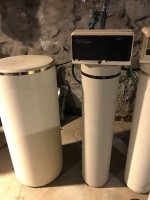Here is a calculation from another thread.
https://terrylove.com/forums/index....ection-system-but-no-chlorine-detected.69734/
Chemical injection pump GPG/Well pump output rate (GPD)xsolution strength= ppm injected.
I am not sure of your chemical injection pump but lets guess 10 gpd
10/43,200x6000ppm=1.4 ppm chlorine injection. If you have 2 ppm of iron, you will not have any residual chlorine.
FYI, a gallon of household bleach is approx. 55,000 ppm
Thank you for that link and reference!! I did come up with some numbers after some calculating.
With that said, I had to first determine the rate at which my well pressure pump is flowing at. After using the method found in the link that Bannerman provided, I got 2 GPM of output. That seems awfully low?? Most treatment systems I see advertised require a minimum of 5 GPM. I have a Well -X-trol WX-202.
Anyways.. my chlorine pump is rated at 60 GPD. It is currently set at 40% stroke volume, so 24 GPD.
Let’s use the 2 quarts of 12.5% chlorine, so 60,000 ppm added to 30 gallons of water is 2,000 ppm.
So.. 24 GPD/2,880 GPD x 2000 ppm = 16.6 ppm chlorine injected. Seems like a lot. But then again, we don’t know how much hydrogen sulfide is in the water. That wasn’t included in the NTL water test.
What is everyone’s thoughts on air injection systems? My neighbor uses this method with good results.

